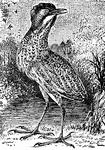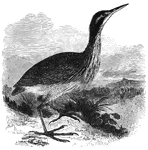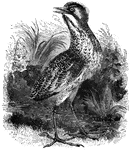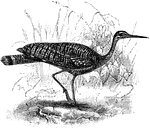Clipart tagged: ‘bittern’

Bittern
"The bitterns are distinguished from the herons proper, besides other characteristics, by having the…

Bittern
"Botaurus. Bittern. Bill moderately longer than head, shorter than tarsus, which is shorter than middle…

The Bill of a Bittern
"Botaurus. Bittern. Bill moderately longer than head, shorter than tarsus, which is shorter than middle…

American Bittern
Measuring approximately twenty-six inches in length, the American bittern is a nocturnal hunter. It…

Common Bittern
The common bittern of Europe feeds at night, primarily on frogs, lizards, small birds, and fish.

Sun-Bittern
"Eurypyga helias, Sun-Bittern, has a black head, with a white stripe above and under each eye, and a…

Sunbittern in Swamp
The Sunbittern (Eurypyga helias) is a bird native to the tropical regions of America.
